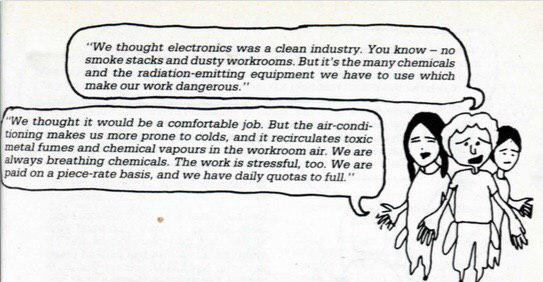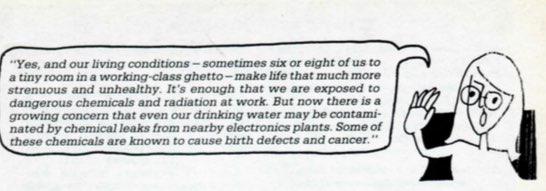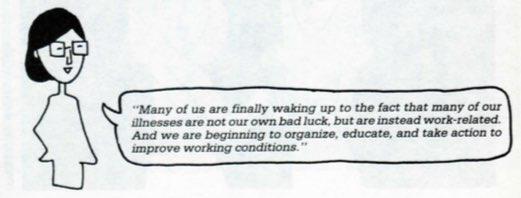by Tom Gassert

The electronics industry is a new industry, and has become for many industrializing nations a symbol of modernization. Electronics is also a chemical industry because to make electronic chips and consumer products several thousand toxic chemicals and chemical processes are required.
Since the late 1950s, a few hundred transnational corporations (TNCs) based in North America, Japan, and Europe have emerged. Many have set up labour-intensive assembly and testing plants, mostly in Asia, where labour is cheap and controlled by authoritarian governments, and where regulations on the use of hazardous chemicals are lax or lacking.
As with other light industries such as textiles, electronics firms prefer to hire women, partly because wage discrimination — unequal pay for equal work - between men and women makes it more economical to hire women, and partly because women are traditionally more tolerant than men in doing detailed monotonous work, less career-oriented, and more loyal and obedient to male authority. Today, 70 to 80 percent of the entire production workforce of the global electronics industry is female, and at least 70 percent of these women workers are Asian.
The myth that the electronics industry is clean, and therefore a safe and healthy place to work, has been shattered. The outward appearance of cleanliness has not been able to hide the terrible toll of human injuries and illnesses caused by chemicals and radiation.
Most of the evidence comes from Silicon Valley in California where journalists, health workers, fire fighters and lawyers have worked hard to record and report cases as they occur. A government survey showed that the rate of illnesses among electronics workers in California is four times higher than the average for all other manufacturing industries.

Acid burns and gassing incidents are most common in Silicon Valley and in Asia. In California, an average of one worker from every major firm every month requires surgery for injuries due to hydrofluoric acid. Some plants have an average of one evacuation every month due to chemical leaks or gassings.
Such emergencies are frequent in Asia. For example, at a US plant in Malaysia, a semiconductor testing machine exploded, injuring several workers and exposing them to high levels of radioactive krypton gas. In Hong Kong, nearly 200 women workers at a Japanese plant were treated in hospital when a label-printing process using ultraviolet light and a solvent called perchloroethylene resulted in the formation of high levels of ozone and phosgene gas. Six out of 13 pregnant workers were reported to have lost their fetuses following the incident, in some cases probably due to the displacement of oxygen in the mothers' blood during the gassing.
Eye problems are very common, especially among workers who must peer all day long into microscopes and TV monitors. Eyestrain has caused many workers, hired with perfect vision, to require prescription glasses after one or two years of work. Conjunctivitis is common among workers who must use the same scope.
Many of the liquid chemicals (such as cleaning and degreasing solvents), metals (such as solders and plating solutions), plastics and glues (such as polymers and epoxy resins), are known to cause skin and lung problems as well as cancer and birth defects. Cases of cancer and birth defects are very difficult to prove.
In the Philippines, one young woman who was exposed daily to cancer-causing solvents, metal fumes, and plastic resin vapours at work for three years became seriously ill with aplastic anemia. She then developed cancer of the lymph with leukaemic transformation, and died painfully at the age of 22. Doctors suspected her illnesses were work-related.

In California's Silicon Valley, women in a local community near a Fairchild Electronics plant noticed an unusually high number of miscarriages and birth defects. When they had their drinking water tested they found high levels of 1,1,1-trichloroethane, acetone, and other chemicals. It was then admitted by Fairchild that 58,000 gallons of solvents and acids had leaked into the ground from chemical storage tanks and had travelled several kilometers polluting an underground water well which provided drinking water to 16,500 families. A three-year government survey found that the rates of miscarriages and birth defects in the affected community were three times higher than normal, and suggested that the chemical leak from the electronics plant was the most probable cause. Lawyers are now handling damage claims amounting to hundreds of millions of US dollars. Meanwhile, nearly 80 percent of electronics plants in Silicon Valley have been discovered to be leaking toxic chemicals.
Problems for many women workers are compounded by the fact that employers exact high performance by paying wages according to quotas. Stress at work contributes to poor health. Jobs depend on performance and obedience. Women are sometimes subjected to sexual harassment by male supervisors, and are often prevented from transferring out of a hazardous job. If a worker becomes pregnant, the employer, not willing to pay maternity benefits, may terminate her.
Some bosses refuse to recognize that difficult menstruation is a problem which needs care. Irregular menstruation has been linked to exposure to aromatic solvents (often used for cleaning, degreasing, or thinning) such as xylene, toluene and benzene. Some women have been known to develop urinary tract infections because they held back from going to the toilet when they had to because they feared poor performance ratings by their supervisors. Some have even resorted to stimulant drugs to keep the pace, or to help them adjust to rotating shift schemes enforced by management.

All of these health problems faced by male and female electronics workers are part of a global syndrome resulting from the reckless transfer of hazardous technologies and chemicals. Asian electronics workers are experiencing a repeat performance of the health problems already suffered by electronics workers in North America, Europe and Japan. While labour laws are enacted to protect the health of workers in the industrial nations, hazardous jobs are exported to places like Asia where laws to protect worker health and safety are inadequate or nonexistent. In effect, the managers of most TNCs are operating on double standards with regard to health and environmental protection.
As already seen in industrial nations improvements can only come about by the efforts of workers and citizens to organize, educate, and take action. Workers are realizing that they know as much about chemicals and work hazards as their bosses. Male workers are joining women workers as comrades to fight the common enemy of industrial health hazards. Trade unions, community health organizations, and environmentalists are beginning to link up to face the challenge of modern chemicals and to demand that industry and governments be accountable for flooding working and living places with inadequately tested chemicals.
For the first time in the history of industrialization, women are in a position to take a leading role in determining the course of modern development. Like the steelworkers who led the trade union movement of the first industrial revolution because steel was a cornerstone industry for modernization, it stands to reason that electronics and chemical workers can lead today's labour movement through the new industrial revolution, the age of electronics technology.

Tom Gassert is the author of Health Hazards in Electronics - A Handbook, to be released in September 1985. Contact address: Asia Monitor, 444 Nathan Road 8/B, Kowloon, Hong Kong.

